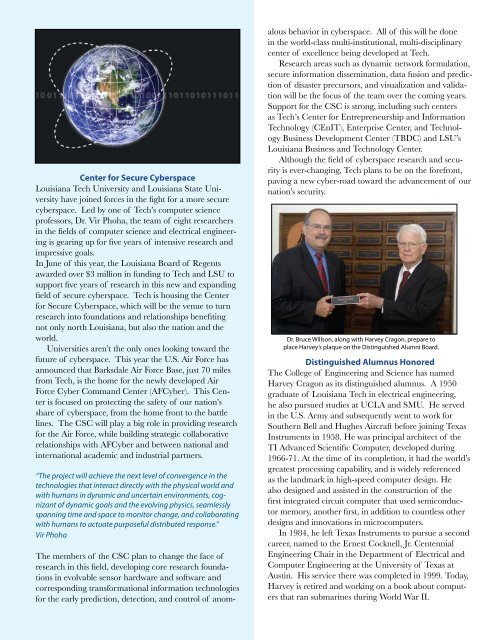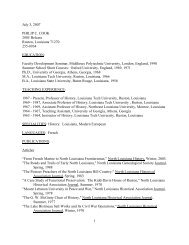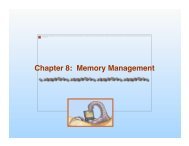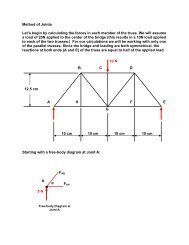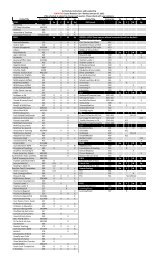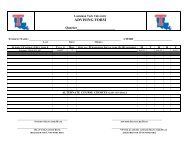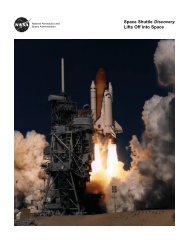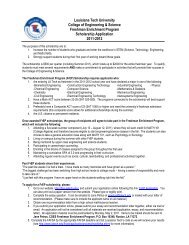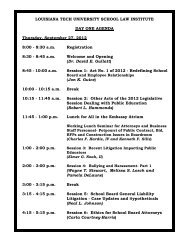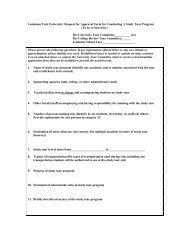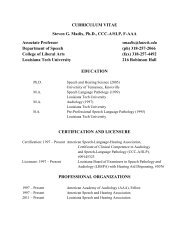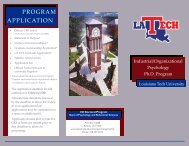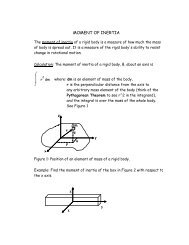Center for Secure Cyberspace - Louisiana Tech University
Center for Secure Cyberspace - Louisiana Tech University
Center for Secure Cyberspace - Louisiana Tech University
Create successful ePaper yourself
Turn your PDF publications into a flip-book with our unique Google optimized e-Paper software.
<strong>Center</strong> <strong>for</strong> <strong>Secure</strong> <strong>Cyberspace</strong><strong>Louisiana</strong> <strong>Tech</strong> <strong>University</strong> and <strong>Louisiana</strong> State <strong>University</strong>have joined <strong>for</strong>ces in the fight <strong>for</strong> a more securecyberspace. Led by one of <strong>Tech</strong>’s computer scienceprofessors, Dr. Vir Phoha, the team of eight researchersin the fields of computer science and electrical engineeringis gearing up <strong>for</strong> five years of intensive research andimpressive goals.In June of this year, the <strong>Louisiana</strong> Board of Regentsawarded over $3 million in funding to <strong>Tech</strong> and LSU tosupport five years of research in this new and expandingfield of secure cyberspace. <strong>Tech</strong> is housing the <strong>Center</strong><strong>for</strong> <strong>Secure</strong> <strong>Cyberspace</strong>, which will be the venue to turnresearch into foundations and relationships benefitingnot only north <strong>Louisiana</strong>, but also the nation and theworld.Universities aren’t the only ones looking toward thefuture of cyberspace. This year the U.S. Air Force hasannounced that Barksdale Air Force Base, just 70 milesfrom <strong>Tech</strong>, is the home <strong>for</strong> the newly developed AirForce Cyber Command <strong>Center</strong> (AFCyber). This <strong>Center</strong>is focused on protecting the safety of our nation’sshare of cyberspace, from the home front to the battlelines. The CSC will play a big role in providing research<strong>for</strong> the Air Force, while building strategic collaborativerelationships with AFCyber and between national andinternational academic and industrial partners.“The project will achieve the next level of convergence in thetechnologies that interact directly with the physical world andwith humans in dynamic and uncertain environments, cognizantof dynamic goals and the evolving physics, seamlesslyspanning time and space to monitor change, and collaboratingwith humans to actuate purposeful distributed response.”Vir PhohaThe members of the CSC plan to change the face ofresearch in this field, developing core research foundationsin evolvable sensor hardware and software andcorresponding trans<strong>for</strong>mational in<strong>for</strong>mation technologies<strong>for</strong> the early prediction, detection, and control of anomalousbehavior in cyberspace. All of this will be donein the world-class multi-institutional, multi-disciplinarycenter of excellence being developed at <strong>Tech</strong>.Research areas such as dynamic network <strong>for</strong>mulation,secure in<strong>for</strong>mation dissemination, data fusion and predictionof disaster precursors, and visualization and validationwill be the focus of the team over the coming years.Support <strong>for</strong> the CSC is strong, including such centersas <strong>Tech</strong>’s <strong>Center</strong> <strong>for</strong> Entrepreneurship and In<strong>for</strong>mation<strong>Tech</strong>nology (CEnIT), Enterprise <strong>Center</strong>, and <strong>Tech</strong>nologyBusiness Development <strong>Center</strong> (TBDC) and LSU’s<strong>Louisiana</strong> Business and <strong>Tech</strong>nology <strong>Center</strong>.Although the field of cyberspace research and securityis ever-changing, <strong>Tech</strong> plans to be on the <strong>for</strong>efront,paving a new cyber-road toward the advancement of ournation’s security.Dr. Bruce Willson, along with Harvey Cragon, prepare toplace Harvey’s plaque on the Distinguished Alumni Board.Distinguished Alumnus HonoredThe College of Engineering and Science has namedHarvey Cragon as its distinguished alumnus. A 1950graduate of <strong>Louisiana</strong> <strong>Tech</strong> in electrical engineering,he also pursued studies at UCLA and SMU. He servedin the U.S. Army and subsequently went to work <strong>for</strong>Southern Bell and Hughes Aircraft be<strong>for</strong>e joining TexasInstruments in 1958. He was principal architect of theTI Advanced Scientific Computer, developed during1966-71. At the time of its completion, it had the world’sgreatest processing capability, and is widely referencedas the landmark in high-speed computer design. Healso designed and assisted in the construction of thefirst integrated circuit computer that used semiconductormemory, another first, in addition to countless otherdesigns and innovations in microcomputers.In 1984, he left Texas Instruments to pursue a secondcareer, named to the Ernest Cocknell, Jr. CentennialEngineering Chair in the Department of Electrical andComputer Engineering at the <strong>University</strong> of Texas atAustin. His service there was completed in 1999. Today,Harvey is retired and working on a book about computersthat ran submarines during World War II.


